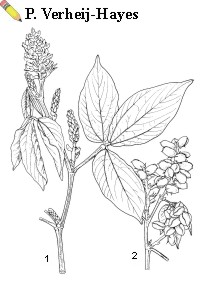Record Number
1091
PROSEA Handbook Number
12(2): Medicinal and poisonous plants 2
Taxon
Flemingia macrophylla (Willd.) Merr.
This article should be read together with the article on the genus: Flemingia in the Handbook volume indicated above in this database.
This article should be read together with the article on the genus: Flemingia in the Handbook volume indicated above in this database.
Protologue
Philipp. Journ. Sci., Bot. 5: 130 (1910).
Synonyms
Flemingia congesta Roxb. ex W.T. Aiton (1812), Flemingia latifolia Benth. (1852), Moghania macrophylla (Willd.) O. Kuntze (1891).
Vernacular Names
Indonesia: apa-apa (Javanese), hahapaan (Sundanese, pok kepokan (Madurese). Malaysia: serengan jantan, beringan. Philippines: laclay-guinan (Tagalog), gewawini (Ifugao), malabalatong (Pampanga). Laos: thwàx h'è: h'üad, thwàx h'üad (Vientiane), h'ôm sa:m müang (Xieng Khouang). Thailand: mahae nok (northern), khamin naang (central), khamin phra (southeastern). Vietnam: t[os]p m[owx] l[as]to, d[aaj]u ma.
Distribution
Flemingia macrophylla originated in and is widely distributed in South-East Asia and in India, Sri Lanka, southern China and Taiwan. It has been introduced and naturalized in Papua New Guinea, northern Australia, East, Central and West Africa and is cultivated in tropical America.
Uses
In Peninsular Malaysia, the entire plant is given to relieve stomach-ache. In India, the roots are applied externally to ulcers and swellings. In China, a decoction is used to bathe swellings and sores. In Taiwan, it is used as an antipyretic in post-partum fevers and to treat paralysis and painful joints.
Observations
A deep-rooting, tussock-forming shrub, 1—4 m tall, young branches ribbed, triangular in cross section; leaves 3-foliolate, petiole up to 10 cm long, leaflets elliptical-lanceolate, 6—16 cm x 4—7 cm, base rounded, apex rounded to acuminate, veins covered with silky hairs, papery, dark green; inflorescence a dense axillary raceme, subspiciform, sessile, 2.5—10 cm long, silky, bracts ovate, 3—6 mm long; calyx 6—13 mm long, pale green, velutinous; corolla standard elliptical, greenish with distinct parallel red veins, wings narrow and much shorter than the keel, light purple at the apex; pod oblong, 8—15 mm x 5 mm, covered with fine glandular hairs, dark brown, 2-seeded; seed globular, 2—3 mm in diameter, shiny black. The natural habitat of Flemingia macrophylla is along watercourses and in brushwood in general under shaded conditions, both on clay and lateritic soils, as well as under drier conditions up to 2000 m altitude.
Image
 | Flemingia macrophylla (Willd.) Merr. - 1, flowering branch; 2, fruiting branch |
Selected Sources
[74] Backer, C.A. & Bakhuizen van den Brink Jr, R.C., 1964—1968. Flora of Java. 3 volumes. Noordhoff, Groningen, the Netherlands. Vol. 1 (1964) 647 pp., Vol. 2 (1965) 641 pp., Vol. 3 (1968) 761 pp.
[135] Burkill, I.H., 1966. A dictionary of the economic products of the Malay Peninsula. Revised reprint. 2 volumes. Ministry of Agriculture and Co-operatives, Kuala Lumpur, Malaysia. Vol. 1 (A—H) pp. 1—1240, Vol. 2 (I—Z) pp. 1241—2444.
[215] Council of Scientific and Industrial Research, 1948—1976. The wealth of India: a dictionary of Indian raw materials & industrial products. 11 volumes. Publications and Information Directorate, New Delhi, India.
[511] Kasahara, S. & Hemmi, S. (Editors), 1995. Medicinal herb index in Indonesia. 2nd Edition. P.T. Eisai Indonesia, Jakarta, Indonesia. 453 pp.
[662] Matthew, K.M., 1981—1988. The flora of the Tamilnadu Carnatic. 4 volumes. The Rapinat Herbarium, St. Joseph's College, Tiruchirapalli, India.
[667] Mehra, K.L., Wulijarni-Soetjipto, N. & Supardiyono, E.K., 1985. Indonesian economic resources: legume and other forage plants. Seri Sumber Daya Alam 124. Lembaga Biologi Nasional - LIPI, Bogor, Indonesia. 51 pp.
[827] Rao, C.P., Vermuri, V.S.S. & Jagannadha Rao, K.V., 1982. Chemical examination of roots of Flemingia stricta (Leguminosae). Indian Journal of Chemistry 21B: 167—169.
[135] Burkill, I.H., 1966. A dictionary of the economic products of the Malay Peninsula. Revised reprint. 2 volumes. Ministry of Agriculture and Co-operatives, Kuala Lumpur, Malaysia. Vol. 1 (A—H) pp. 1—1240, Vol. 2 (I—Z) pp. 1241—2444.
[215] Council of Scientific and Industrial Research, 1948—1976. The wealth of India: a dictionary of Indian raw materials & industrial products. 11 volumes. Publications and Information Directorate, New Delhi, India.
[511] Kasahara, S. & Hemmi, S. (Editors), 1995. Medicinal herb index in Indonesia. 2nd Edition. P.T. Eisai Indonesia, Jakarta, Indonesia. 453 pp.
[662] Matthew, K.M., 1981—1988. The flora of the Tamilnadu Carnatic. 4 volumes. The Rapinat Herbarium, St. Joseph's College, Tiruchirapalli, India.
[667] Mehra, K.L., Wulijarni-Soetjipto, N. & Supardiyono, E.K., 1985. Indonesian economic resources: legume and other forage plants. Seri Sumber Daya Alam 124. Lembaga Biologi Nasional - LIPI, Bogor, Indonesia. 51 pp.
[827] Rao, C.P., Vermuri, V.S.S. & Jagannadha Rao, K.V., 1982. Chemical examination of roots of Flemingia stricta (Leguminosae). Indian Journal of Chemistry 21B: 167—169.
Author(s)
L.J.G. van der Maesen
Correct Citation of this Article
van der Maesen, L.J.G., 2001. Flemingia macrophylla (Willd.) Merr.. In: van Valkenburg, J.L.C.H. and Bunyapraphatsara, N. (Editors): Plant Resources of South-East Asia No 12(2): Medicinal and poisonous plants 2. PROSEA Foundation, Bogor, Indonesia. Database record: prota4u.org/prosea

All texts are licensed under a Creative Commons Attribution-Noncommercial-Share Alike 3.0 Netherlands License
This license does not include the illustrations (Maps,drawings,pictures); these remain all under copyright.